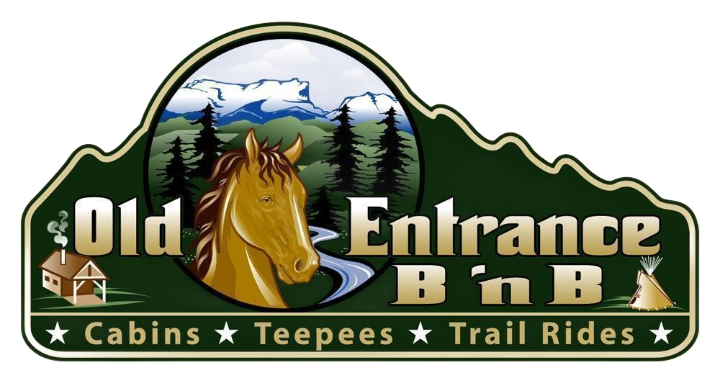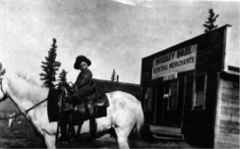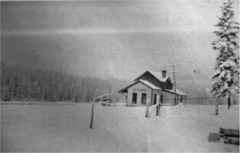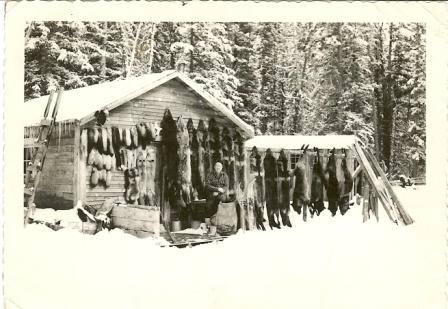

The historic Canadian Northern Railway ENTRANCE Station is the main house for Old Entrance Bed 'n Breakfast Cabins.
The original site of Entrance, Alberta (now known as Old Entrance) is situated along the north bank of the Athabasca River in the foothills of west central Alberta. Canadian Northern Railways surveyed their railway line through this location in 1909 from Edmonton to Tete Jaun Cache with preliminary work having been undertaken three years earlier. A station or section house was situated every eight to ten miles along the railway. Roy Woodley filed homestead on vacant land SW2-51-26-W5 at the location he called "Entrance" in 1913 and obtained government contract to operate Entrance Post Office which he ran from his general store, opened for business in 1914 and operated at this Entrance location until 1927. CNoR opened their railway station named ENTRANCE in 1914 providing rail service through to the near-by Brule coal mine, then onwards to the west coast port at Vancouver. Early railway plans indicate that their railway station at this location was to be called HEDA. This location was known as Entrance due to the proximity to Jasper Forest Park, a vast forest reserve area laid out in 1907 with it's north-west diagonal boundary line crossing the CNoR railway line a short distance west of Entrance near Orchard Creek. A portion of this forest reserve became Jasper National Park in 1909 and the Athabasca Forest Reserve was established north of the Athabasca River in 1912. Headquarters office for the Dominion Forest Service's Athabasca Forest Reserve was maintained at Entrance from 1916 until 1930, at which time jursidiction for forestry was turned over to the province of Alberta.
The CNoR was the first rival company to the Canadian Pacific Railway (CPR)in western Canada. As a colonization railway the CNoR began constructing rail lines during the late 1890's building lines cheaply into areas where development could be expected and not improving their facilities until revenues justified the upgrading. This second railway was important as it provided an alternative to the CPR for moving wheat from the prairies.
The CNoR rail line west of Edmonton had to depend on transcontinental traffic to earn its keep. From Edmonton to Red Pass the railway ran within sight of a third rival company, the Grand Trunk Pacific Railway (GTPR), whose terminus was Prince Rupert. The government of the day could not persuade these two new railways to share one line along this route. Both companies received financial aid for their separate transcontinental rail lines and were completed from coast to coast in 1914 and 1915. The CNoR also ran parallel with CPR line from Kamloops to Vancouver.
Ultimately, the duplication of the rail lines and the end of the economic boom resulted in the financial collapse of the two companies and the nationalization of the CNoR in 1918 and the GTPR in 1920. Out of these two railways and a few smaller companies emerged CNR, Canadian National Railways officially in 1922. The GTPR grade had been constructed to higher standards and almost all of the CNR main line west of Winnipeg, Manitoba makes use of the original GTPR grade today. One exception is the section of rail line west of Old Entrance, from Solomon to Jasper which runs on the original CNoR grade. During World War I the decision was made to reduce to one track and the railway steel was removed from sections of both tracks for use in Europe from running from Chip Lake to the Yellowhead Pass. Following removal of the steel tracks much of the abandoned railway grade between Edmonton and Jasper was utilized as a roadway. The GTPR built PARK GATE station was constructed at the boundary of Jasper Forest Park on the south side of the Athabasca River across from Solomon Creek, a few miles upstream of Entrance.
In 1926 CNR abandoned the railway line running from Obed to Dyke and abandoned the CNoR line running through Entrance, however the portion of the GTPR grade south-east of Brule Lake had been buried in the shifting sand in the area and was never reused. Three miles of new railway line was built and a new railway bridge (trestle) crossing the Athabasca to connect the GTPR line west the CNoR line on the north side of the river near Solomon Creek and east of the Brule coal mine.

During the time the CNoR operated through Entrance, it was the central gathering point of the forestry, trappers, guides and outfitters. Grande Cache area trappers and others in the region brought their furs to Entrance to trade for supplies. A small settlement developed around the station building.
My maternal grandfather, Roy Woodley, came to Alberta from Ontario with his brother Earl in 1911 working with the CNoR railway survey crew constructing the railway grade and laying steel. Roy was one of a handful of individuals in the area with a camera at the time and took numerous photographs in these early years.
Roy met Theodora (Dora) Webb at Hinton, Alberta, the end of the line for passenger service on the GTPR in early 1912. Dora had travelled from England to western Canada with her friend Connie Nickerson with intentions of going to the west coast. These two young women were among thousands of men in the area at that time involved with the construction of two major railway bridges for the two railways, the GTPR crossing at Prairie (Maskuta) Creek and the CNoR crossing of the Athabasca River near Entrance. Roy and Dora were married in 1914 and settled on the quarter section SW2-51-26-W5 lying north of the Athabasca River at Entrance, obtaining land title in 1919.
Earl Woodley, Roy's younger brother continued work with CNoR until completion of their transcontinental line, then joined in partnership with Roy operating as Woodley Bros. General Merchants, store and Entrance Post Office adjacent to the CNoR station at Entrance. A restaurant and poolroom were also established on this property alongside of the general store. Earl Woodley married Edna (daughter of Ward Badgley, the district Forest Superintendent at Entrance) on October 23, 1921. They purchased the Red Pass Hotel and relocated in 1923 operating the hotel and E.F. Woodley General Merchandise until retirement to Abbotsford B.C. in 1946.
In 1923, with his growing number of children, Roy Woodley had a log schoolhouse constructed at Entrance, but in 1926 with completion of the trestle west of Entrance the CNR main line by-passed this location. The rail line remained in place through Old Entrance as a spur line for the CNR to the Bliss gravel pit until 1932.
Roy Woodley sold his store business and post office to Tom Monaghan in 1925. Tom leased the store building from Roy for two years while constructing a new building near the Dyke station one mile east and on the opposite side of the river in 1927. With the relocation of the Entrance Post Office, the railway station on the GTPR line at Dyke was renamed Entrance. The original location of Entrance is now known as "Old Entrance", however for many years this location was referred to as Entrance and the south side location as "new" Entrance.
The Roy Woodley family relocated near Hinton onto a new homestead filed in Dora's name in 1933. Roy and Dora had thirteen children with the last two being born after they left Entrance. Roy Woodley sold his property at Entrance to his brother Earl in 1945 and Earl retained ownership until 1954, then selling it to my paternal grandmother's cousin, Wilbert (Billy) Magee who resided here until his death in 1987. Mary Luger purchased this property (her grandfather's original homestead) from the Magee estate.
Entrance headquarters of the Dominion (federal) Athabasca Forest Reserve consisted of several log structures; the superintendent residence, ranger cabin bunkhouse and barn. Alberta Forestry Department maintained a ranger office at Entrance for many years on the crown land adjacent to the Woodley homestead. The original superintendent's house was torn down and replaced with a frame bungalow in 1948 to house the district ranger and his family. Following a house fire a second bungalow was placed in the 1960's. In recent years, three small lots were surveyed from crown land, transferred to Alberta Housing (a crown corporation) and sold directly to "user department employees". These small lots do not comply with country residential zoning requirements in effect for subdivision of privately owned land.

Following removal of the railway tracks 1932 the 100' wide right-of-way was leased and the station building occupied as a private dwelling.
The station building was sold by CNR in 1932. It was first occupied by retired railway telegrapher Alan Boomer, who sold the building to guide and outfitter Harry Ennis in 1940 for $75 who subsequently sold to Billy Magee when Billy acquired the Woodley homestead in 1954. Billy initially resided in this railway station building prior to moving into a surplus forestry service cabin (White Cabin) that had been moved onto his property for forest ranger Rex Winn's residence. The photo below is of Billy Magee taken in 1954 at his trapper's cabin on Tie Camp Creek trapline.

Alberta Transportation took over property management from CNR in the 1960's of the railway right-of-way lease of public lands on which the station building was located. Following Billy Magee's death in 1987, Alberta Transportation transferred the right-of-way lease to the station building tenant occupant. Shortly afterwards the station building was advertised for sale by public tender for removal from the site. The single bidder Mary Luger paid Alberta Transportation $1313.13 for this building. Following replacement of the deteriorated floor joists to ensure that the building walls would be supported during the move, the building was moved off the right-of-way. The building sat on blocks for nine years, then in 1998 was placed onto a new foundation just north of it's original site. The 100' wide right-of-way through the property was acquired from the province to provide legal access.
Several books have various accounts of events that took place at Entrance and throughout the surrounding area. Pack Saddles to Tete Jaune Cache by J.G. MacGregor is a chronicle of the life of James Shand-Harvey who resided in the Entrance area from 1909 until his death in 1968. From 1921 his main residence was a small log cabin located on Roy Woodley's land at Old Entrance. Shand was a trapper and early forest ranger. Of upper class English descent, he was educated at Eton and with his school friend, the Queen's grandson, had taken Sunday tea with Queen Victoria. Shand was later in attendance at a meeting where the Metis residents of Jasper National Park were requested to move from the park and were told that they could settle anywhere in the Province of Alberta outside of the national park. After relocating to the Grande Cache area they were asked to leave the Athabasca Forest Reserve and move onto surveyed land. Shand had been in attendance during the original "deal making" and became a staunch ally of these people, assisting them to remain at their Grand Cache area locations where they have obtained leases to the land they occupy.
Trail North by Robert Guest is a pictorial compilation that traces the trail that passes through Old Entrance to the Peace River country. Shand's cabin and the log schoolhouse (still standing) are splendidly portrayed.
History of Hinton by Hazel Hart provides an abundance of information on our local history.
The recently released, If Moose Could Only Talk by Neil Gilliat recounts amusing tales told by the area old-timers while he was employed by the Alberta Forest Service at Entrance in the late 1940's.
Old photograghs: Roy Woodley Collection (Mary Luger)
Mary Luger, Last Update March 2, 2009 Photos are not to be reproduced without my written permission.


